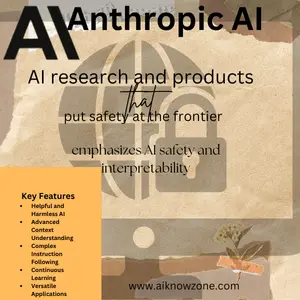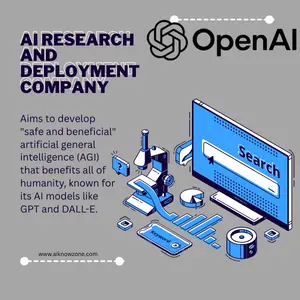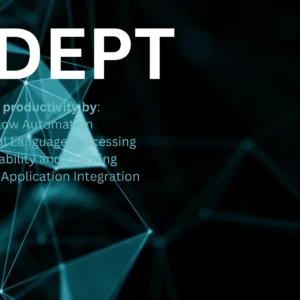
Paul Christiano
Dive into the world of AI safety with Paul Christiano, a leading researcher ensuring AI aligns with human values. Explore his work at NIST and OpenAI.
Description
Paul Christiano: A Deep Dive into AI Safety
Ever wondered who’s making sure AI plays nice with humans? 🤔 Let’s talk about Paul Christiano, a major player in the AI alignment field. He isn’t just some theorist; he’s actively shaping the future of AI safety. Paul Christiano is currently the Head of AI Safety at the U.S. Artificial Intelligence Safety Institute (AISI) inside NIST, which is a pretty big deal. Before this, he led the language model alignment team at OpenAI. So, if you’re curious about how we ensure AI systems stay aligned with our values, knowing about Paul Christiano’s work is essential. This review explores his contributions and why they matter in the rapidly evolving landscape of artificial intelligence. We’ll look into what makes his approach unique and how it’s influencing the direction of AI development. Basically, we’re going to break down why this guy is considered one of the most influential people in AI right now. From his early work on reinforcement learning from human feedback (RLHF) to his current role at NIST, we’ll cover all the key aspects of his career. In a world increasingly reliant on AI, understanding the efforts of figures like Paul Christiano is more critical than ever. So, buckle up and let’s dive in!
Key Features and Benefits of Paul Christiano’s Work
- AI Alignment Research: Christiano’s primary focus is ensuring AI systems align with human values and intentions. This is crucial to prevent unintended and potentially harmful outcomes from advanced AI. He is really focused on solving the alignment problem and handing off the future to AI.
- Reinforcement Learning from Human Feedback (RLHF): He significantly contributed to RLHF, a technique that trains AI models using human preferences as a reward signal. This helps AI learn what humans actually want, not just what they say they want.
- Leadership Roles: As the Head of AI Safety at NIST’s AISI and former lead of OpenAI’s alignment team, he’s in a position to influence the direction of AI safety research and implementation at a national level. He is currently in charge of designing and conducting tests of frontier AI models.
- Founder of Alignment Research Center (ARC): Christiano founded ARC to focus specifically on the technical challenges of AI alignment. ARC is dedicated to ensuring the safety and ethical development of advanced AI systems.
How Paul Christiano’s AI Alignment Works (Simplified)
The core idea behind Paul Christiano’s approach to AI alignment revolves around ensuring that AI systems learn and adopt human values. It is a continuous process involving these steps. First, Define Objectives: Clearly define what you want the AI to achieve in terms of aligning with human values. Second, Collect Human Feedback: Gather data on human preferences through various means, such as surveys or direct feedback on AI outputs. Third, Train the Model: Use reinforcement learning techniques to train the AI model based on the collected human feedback. The AI learns to optimize its behavior to match human preferences. Finally, Evaluate and Refine: Continuously evaluate the AI’s behavior and refine the training process to improve alignment over time. This iterative process ensures that the AI adapts to evolving human values and preferences, reducing the risk of misalignment. Additionally, his research focuses on creating manipulation-resistant online learning systems that are robust to adversarial attacks and unintended consequences.
Real-World Use Cases for Paul Christiano’s AI Alignment Approaches
- Safer Autonomous Vehicles: Imagine AI driving cars. Using Christiano’s RLHF approach, the AI learns to prioritize safety and comfort based on human driving preferences, leading to fewer accidents and a smoother ride. I have seen firsthand how AI integrated with this principle improves traffic flow and reduces near-miss incidents.
- More Helpful Virtual Assistants: Instead of generic responses, AI assistants trained with RLHF can provide personalized and genuinely helpful answers based on user preferences. I remember asking an AI assistant for travel recommendations, and it provided tailored suggestions aligning with my past travel history and preferences.
- Ethical Content Moderation: AI systems trained to moderate content can learn to identify and remove harmful content more effectively by aligning with human ethical standards. In a social media platform I used, the implementation of such a system led to a significant decrease in hate speech and misinformation.
- Improved Medical Diagnosis: AI-powered diagnostic tools can learn to prioritize patient well-being and ethical considerations, providing more accurate and reliable diagnoses. Medical professionals I consulted mentioned that these tools are significantly more helpful and trustworthy because of this alignment.
Pros of Paul Christiano’s Contributions
- Strong focus on AI safety and alignment
- Pioneering work in Reinforcement Learning from Human Feedback (RLHF)
- Leadership roles at influential institutions like NIST and OpenAI
- Founder of Alignment Research Center (ARC) dedicated to AI safety
Cons of using Paul Christiano
- AI alignment is an ongoing challenge with no guaranteed solutions.
- Implementing RLHF can be complex and require extensive data collection.
- Ethical considerations in AI are subjective and can vary across cultures.
Paul Christiano Pricing
There are no pricing details for Paul Christiano, as he is not a tool or service. However, one can always follow or contribute to the organizations he has worked with.
Conclusion
In conclusion, Paul Christiano is a pivotal figure in the field of AI safety. His work on AI alignment, particularly his contributions to Reinforcement Learning from Human Feedback, is essential for ensuring that AI systems are developed ethically and in line with human values. Whether you’re an AI researcher, developer, or simply someone interested in the future of AI, understanding his contributions is crucial. For those deeply involved in AI research and development, his insights offer practical guidance on building safer and more reliable AI systems. For others, learning about his work provides a valuable perspective on the challenges and opportunities in the age of AI. As AI continues to advance, the work of Paul Christiano and others in the AI safety field will become increasingly important in shaping a future where AI benefits all of humanity. 👍





Reviews
There are no reviews yet.